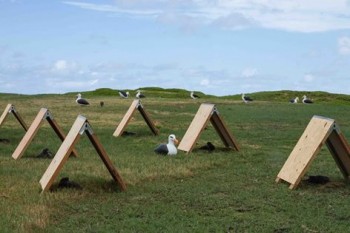A three-year project to create a new colony of Laysan Albatrosses Phoebastria immutabilis in the James Campbell National Wildlife Refuge on the Hawaiian island of Oahu has been completed with a 92% fledging rate. The hand-reared chicks have come from eggs removed from the Pacific Missile Range Facility Barking Sands on the nearby island of Kauai.

Hand-reared Laysan Albatross chicks waiting for a feed
“17 Laysan Albatross fledged from James Campbell NWR this summer. The project’s goal is to match the fledging success of wild birds, which ranges from 60 to 80 percent. The first two years saw 29 chicks fledge with relatively few issues apart from the ever-present stench of fish slurry and the nights of worry that go with raising seabird chicks from hatching to fledging. ... After three years, 46 chicks had fledged out of 50 relocations, putting the fledging rate at 92 percent - far above the fledging success of wild birds. After spending three to five years at sea, these chicks will hopefully return to the place they were raised - James Campbell NWR … and start the process of selecting a mate for breeding. If they do, the project will be deemed a success …”.

Hand-reared Laysan Albatross chicks keep to the shade in the James Campbell National Wildlife Refuge
Read previous ALN postings on translocated albatrosses at the James Campbell NWR.
Read more here on year three of the project:
John Cooper, ACAP information Officer, 21 September 2017

 English
English  Français
Français  Español
Español